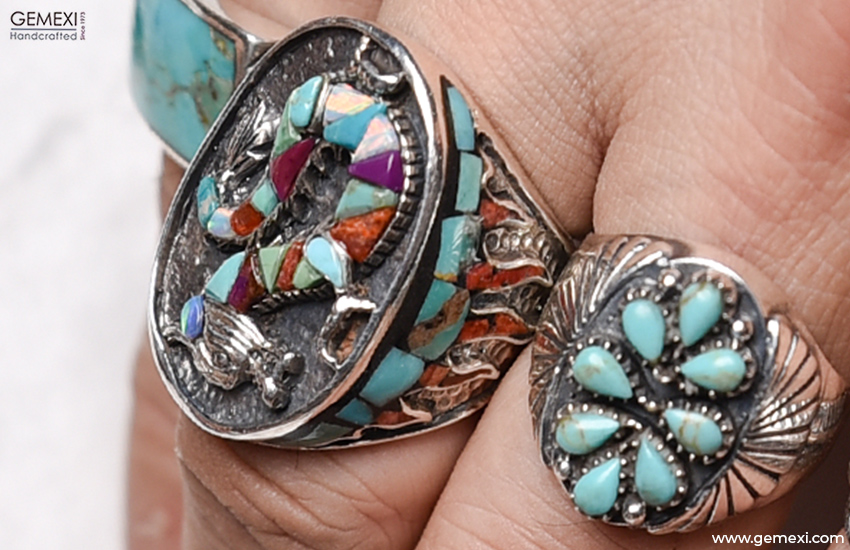The Intricate Artistry of Native American Tribes: An Exploration of Cultural Richness and Jewelry Making
By Gemexi Team | Turquoise- Updated On Jun 26, 2023

Native American culture is a complex tapestry woven with fascinating traditions, compelling stories, and exquisite artistry. This richness is clearly reflected in the distinct jewelry styles crafted by various tribes, which not only serve as stunning adornments but also offer insights into their heritage. Let's embark on an illuminating journey through the cultures of several notable Native American tribes and their jewelry making traditions.
- Navajo (Diné) Tribe: The largest Native American tribe in the U.S., the Navajo people, known in their language as Diné, inhabit regions across Arizona, New Mexico, and Utah. They are renowned for their mastery in silversmithing, a skill introduced to them by the Spanish in the mid-19th century. Their jewelry often incorporates intricate stamping and overlay techniques, featuring turquoise, coral, and other semi-precious stones set in silver. Famous Navajo jewelers include Tommy Singer and Kenneth Begay, who have elevated Navajo jewelry to high art.
- Hopi Tribe: Residing in northeastern Arizona, the Hopi tribe is acclaimed for its silver overlay technique, which contrasts a polished silver top layer with a darker oxidized bottom layer. Hopi jewelry often depicts spiritual symbols and ceremonial themes inspired by the tribe's rich folklore. Charles Loloma and Verma Nequatewa (Sonwai) are among the renowned Hopi jewelers known for their innovative designs.
- Zuni Tribe: The Zuni people, based in western New Mexico, are celebrated for their intricate inlay work and stone carving. They create detailed mosaic-like inlay designs using turquoise, shell, jet, and coral set into silver. Their fetish carvings, representing animal and spiritual figures, are also iconic. Notable Zuni jewelers include LeekyaDeyuse and Dan Simplicio.
- Santo Domingo (Kewa Pueblo) Tribe: The Santo Domingo tribe, or Kewa Pueblo, is located in New Mexico. They are celebrated for their skill in creating heishi beads—tiny, handmade shell or stone beads strung together to create necklaces. Santo Domingo jewelry often showcases earth-toned natural materials, such as turquoise, shell, and bone. Santo Domingo artists like Robert Tenorio continue these traditional methods while adding contemporary styles.
- Oglala Lakota (Sioux) Tribe: Part of the Great Sioux Nation, the Oglala Lakota people are based primarily in South Dakota. Their jewelry is often characterized by the use of bone, wood, and quills, reflecting their resourceful adaptation to the Plains environment. Native American artist Kevin Pourier is known for his intricate buffalo horn spoons and jewelry.
- Cherokee Tribe: One of the most recognized tribes, the Cherokee, originally hailed from the Southeastern U.S. but now mainly reside in Oklahoma and North Carolina due to the Trail of Tears. Their jewelry often incorporates intricate beadwork and woven patterns, with designs inspired by nature and tribal history. Cherokee artists like Martha Berry are known for their traditional beadwork jewelry.
- Choctaw Tribe: Predominantly found in Oklahoma, Mississippi, and Louisiana, the Choctaw people are known for their traditional beadwork and silver jewelry. Nature-themed motifs, such as flowers, birds, and the sun, are recurring designs in their creations. Choctaw jeweler Kristen Dorsey, known for her high-end pieces, draws inspiration from her tribal heritage.

These are just a handful of the numerous Native American tribes that contribute to the rich tapestry of indigenous art and culture. Each tribe, with its unique history, beliefs, and aesthetic, brings something special to the collective, making the realm of Native American jewelry an endless source of fascination. As we appreciate these stunning works of art, we also honor the heritage, creativity, and resilience of the Native American tribes that create them.










0 Comments
Write Comments